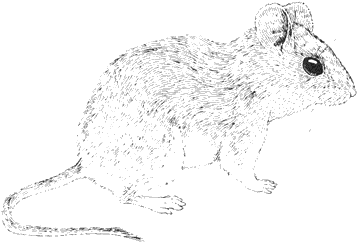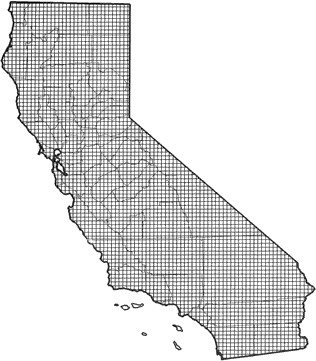
Deer Mouse
Distribution, Abundance, and Seasonality
Abundant or common throughout California in virtually all habitats. Most ubiquitous and abundant mammal in California and North America.

Range Map
Specific Habitat Requirements
Feeding: Consumes a wide variety of food items, including seeds, fruits, leaves, fungi, insects (especially larval and pupal stages), and other animal material. Forages mainly on ground, occasionally climbs shrubs. Large caches may be stored for winter use. Probably prefers insects in spring and fall, but switches to grains as insects become scarce (Jameson 1952).
Cover: Cover is provided by brush piles, litter, logs, rocks, vegetative ground cover.
Reproduction: Nests are constructed in almost any form of confined cover, in rock piles, beneath logs, in slash or forest litter, and in abandoned burrows. Nests are lined with a variety of materials such as grasses, mosses, root fibers, hair (Maser et al. 1981).
Water: Probably searches out free water sources; also obtains water from food and dew.
Pattern: No specific pattern required. Most abundant in early seral stages of forest/woodland habitats (open and moderate canopy) and in moderate to dense canopy of shrub habitats.
Species Life History
Activity Patterns: Nocturnal. Active above ground year-round.
Seasonal Movements / Migration: None.
Home Range: Home range averaged 0.1-0.2 ha (0.25-.50 acres) (Storer et al. 1944). Densities of up to 10-25/ha (4-10/ac) have been reported (Verner and Boss 1980).
Territory: Females may defend a territory during breeding season (King 1968).
Reproduction: Breeds year-round, probably peak ing from March to August . Reproductive cycle varies geographically and annually according to climatic conditions, habitats, and elevation (Jameson 1953). Solitary nesters. Gestation period 22-25 days (Layne 1968). Litter size averages 3.5 young (range 1-9) (Sheppe 1963). Two to 4 litters per yr. Young raised by mother and weaned at 22-37 days (Svihla 1932). Sexual maturity usually obtained at about 50 days (Clark 1938).
Niche: The deer mouse is a small-bodied omnivore. Its wide-spread distribution makes it sympatric with most mammals in the state. Competes with Peromyscus truei, P. californicus, and P. boylii in chaparral habitats, and with P. californicus and P. boylii in riparian woodland habitats. Least arboreal of the North American Peromyscus. Important prey for many predators, which include raptorial birds, snakes, omnivorous mammals, and grasshopper mice. The deer mouse may play an important role by feeding on larvae and pupae of insects detrimental to trees. Conversely, if predators are eliminated, may become a serious pest. Deer mice have been blamed for depredation on seeds during the reforestation of commercially important Douglas-fir (Hooven 1958).
Comments: Reported to be equally common in grazed and ungrazed sagebrush habitat, but significantly more common in ungrazed versus grazed grassland (Reynolds 1980).
Sources & References
California Department of Fish and Game, 1999.
California's Wildlife, Sacramento, CA.
Written by: P. Brylski, reviewed by: H. Shellhammer, edited by: R. Duke
Clark, F. H. 1938. Age of sexual maturity in mice of the genus Peromyscus. J. Mammal. 19:230-234. Hooven, E. F. 1958. Deer mouse and reforestation in the Tillamook Burn. Oregon For. Lands Res. Cent., Corvallis. Res. Note No. 37. 31pp. Ingles, L. G. 1965. Mammals of the Pacific states. Stanford Univ. Press, Stanford, CA. 506pp. Jameson, E. W., Jr. 1952. Food of deer mice (Peromyscus maniculatus and Peromyscus boylii) in the northern Sierra Nevada, California. J. Mammal. 33:50-60. Jameson, E. W., Jr. 1953 Reproduction of dder mice (Peromyscus maniculatus and Peromyscus boylii) in the Sierra Nevada, Calfornia. J. Mammal. 34:44-58. King, J. A., ed. 1968. Biology of Peromyscus (Rodentia). Amer. Soc. Mammal. Special Publ. No. 2. 593pp. Layne, J. N. 1968. Ontogeny. Pages 148-253 in J. A. King, ed. Biology of Peromyscus. Am. Soc. Mammal. Special Publ. No. 2. 593pp. Maser, C., B. R. Mate, J. F. Franklin, and C. T. Dyrness. 1981. Natural history of Oregon coast mammals. Pac. Northwest For. And Range Exp. Sta., USDA, For. Serv., Gen. Tech. Rep., PNW-133. 496pp. Reynolds, T. D. 1980. Effects of some different land management practices on small mammal populations. J. Mammal. 61:558-561. Sadleir, R. M. F. S. 1974. The ecology of the deer mouse, Peromyscus maniculatus, in a coastal confierous forest. II. Reproduction. Can. J. Zool. 52:119-131. Sheppe, W. A. 1963. Population structure of the deer mouse, Peromyscus, in the Pacific Northwest. J. Mammal. 44:180-185. Storer, T. I., F. C. Evans, and F. G. Palmer. 1944. Some rodent populations in the Sierra Nevada of California. Ecol. Monogr. 14:166-192. Svihla, A. 1932. A comparative life history study of the mice of the genus Peromyscus. Univ. Mich. Mus. Zool., Misc. Publ. No. 24. 39pp. Verner, J., and A. S. Boss. 1980. California wildlife and their habitats: Western Sierra Nevada. USDA, For. Serv. Gen. Tech. Rep. PSW-37. 439pp.
California Animal Facts | California's Wildlife